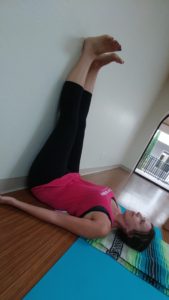When grief takes over the body
By Nancy B. Loughlin
Published in News Press on August 2, 2017
I wouldn’t know an emotion if I tripped over it.
I’m a mind person, a Jnana yogi. If anyone asks me how I’m feeling, my response never fails to begin, “I think…”
As body people seek outlets in the emotions, and emotional people find refuge in the mind, intellectuals bury their stuff in the body.
I know this to be true because I am at war with my back.
It’s not new. Upon close inspection of my high school prom picture, my seventeen-year-old left shoulder is noticeably higher than my right. It’s riddled with muscle knots. It’s where my emotions have always hidden.
November, 2015.
I stood over my mother in her hospital bed. Several weeks prior, she took a spill in her bathroom, hit her head, and was down for more than a day by the time police arrived.
I looked down at her serene face, and I knew she was slipping away, her will, her intellect, her memory, her body. Her life.
My father died two years before. Now my mother, the one person who knew me best in this world, would be gone, too. I was 48 and without a family of my own.
I reached across the bed with my right hand to sweep a strand of hair from her forehead. A sensation I can only describe as the plunge of an icepick jolted my deltoid and slapped my arm back to my side, rendering it useless.
The long-dormant emotional storehouse pushed waves of spasming heat from my left shoulder, across my trapezius muscles and midback and down my right arm.
What the hell? I couldn’t lift my arm above my head, across the front of my body or reach behind me.
The next day, I was booked to run the New York City Marathon. Friends and family suggested I run for my mother, and they would track me online. Despite the aches rocking my right side, I made it to the start line and launched with my wave. Every time the sea of runners crossed a bridge, everyone threw their hands into the air with a whoop.
My arms remained fixed at my sides, and that’s a tough way to run. In all the pictures, I look dead.
After my mother passed peacefully a week later, I returned to Florida and visited with personal trainer Ari Garrido. He stood behind me and asked, “What’s with this posture?” and pulled back my shoulders. I yelped.
My shoulders were spiraling toward each other, and my chin dipped to the floor. My upper body was contorting to protect my heart center. My chest was collapsing as a storm of tension and pain populated the space behind my heart.
It definitely hurt. And it still does.
In her book You Can Heal Your Life, Louise Hay wrote we create every “so-called” illness in the body. She argues the back represents our support system, and pain in that area, or any “dis-ease,” is a result of feeling unsupported and unloved. Pain in the upper back is the lack of emotional support and the midback is guilt.
When I’m alone, I still, robotically, dial my mother’s phone number. I catch myself, hang up the phone, and think about her lying on the floor, alone.
My back howls even if I don’t.
Grief Heart Opening
 First, I stand facing the wall and press my front body against it. My right arm is open to T, parallel to the floor. I push my palm against the wall as I peel my body away from the wall and feel the deep stretch in my chest and the arm behind me.
First, I stand facing the wall and press my front body against it. My right arm is open to T, parallel to the floor. I push my palm against the wall as I peel my body away from the wall and feel the deep stretch in my chest and the arm behind me.
 Then, I move to the floor and slide a block between my shoulder blades. I let my head hang back. I imagine that block is my mother’s familiar hand, patting my back, comforting me. My heart pushes through my chest, rising.
Then, I move to the floor and slide a block between my shoulder blades. I let my head hang back. I imagine that block is my mother’s familiar hand, patting my back, comforting me. My heart pushes through my chest, rising.
 Finally, while I am still on the floor, I remove the block and slide my legs up the wall. I inhale as much as I can. I fill my belly, and I filll my chest. When I think I can accept no more oxygen, I quickly snap three more breaths, one for my father, my mother and me. I feel the box crack open.
Finally, while I am still on the floor, I remove the block and slide my legs up the wall. I inhale as much as I can. I fill my belly, and I filll my chest. When I think I can accept no more oxygen, I quickly snap three more breaths, one for my father, my mother and me. I feel the box crack open.
And I move on.
